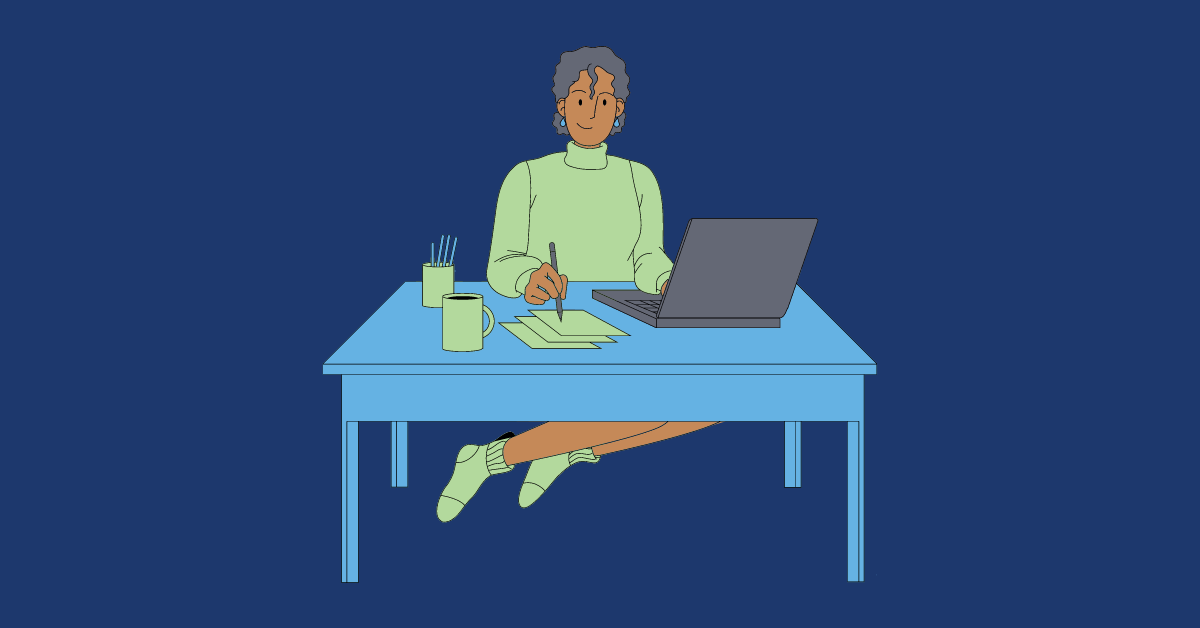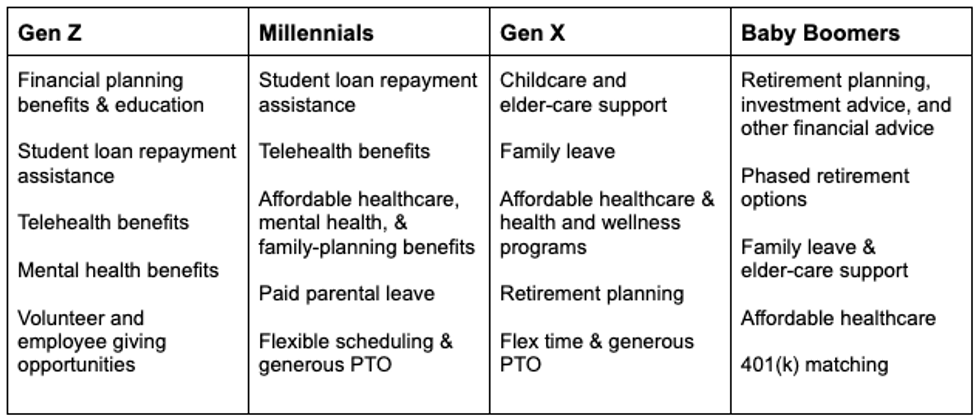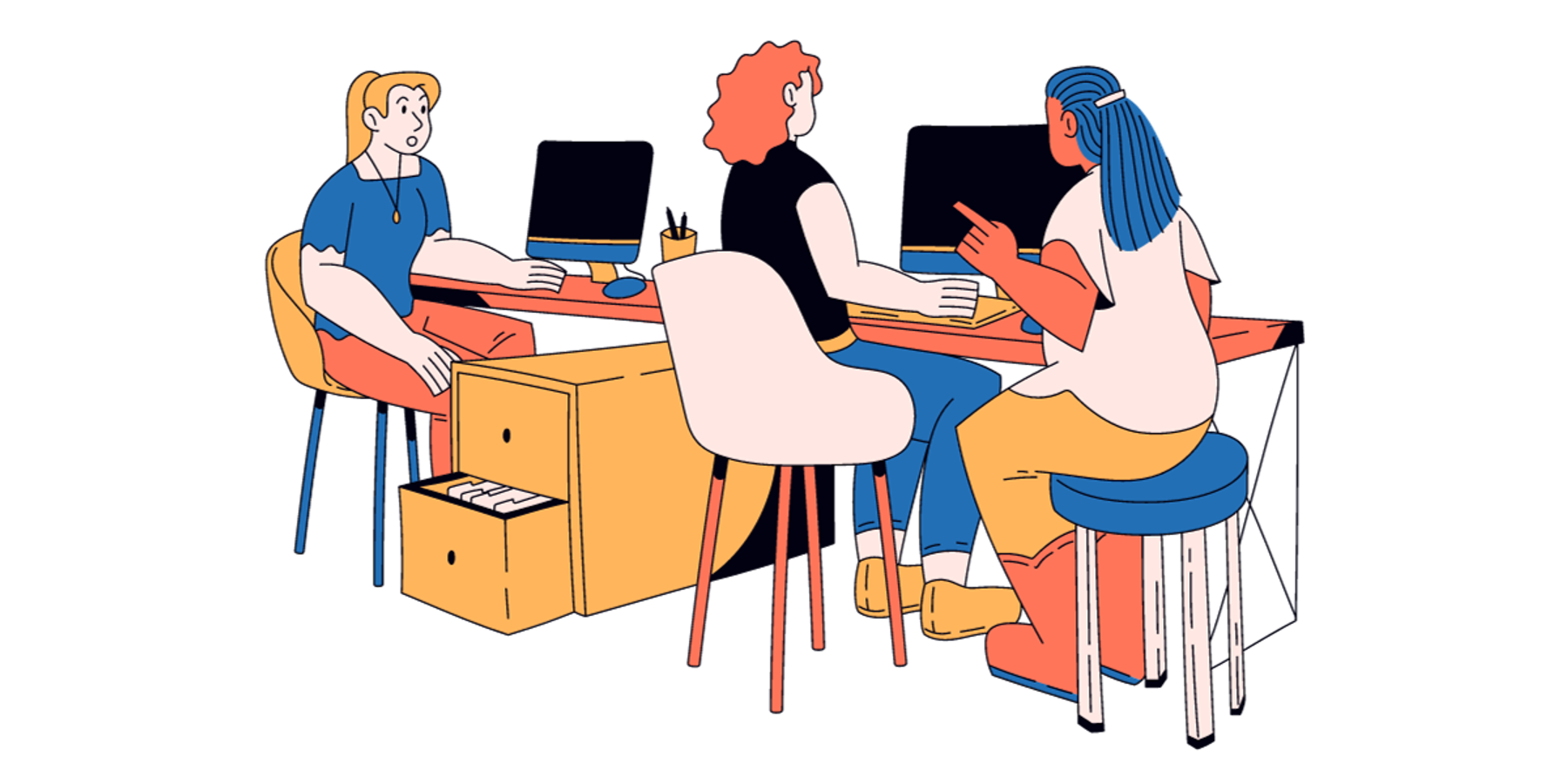Is your organization fostering generational diversity in the workplace? How about setting up leaders to manage multigenerational teams?
A Deloitte study says you might not be: The study found that while 70% of organizations surveyed said leading multigenerational workforces would be important or very important for their success over the next year, only six percent said their team leaders were equipped to effectively manage one.
This, when generational diversity could be a boon for many workplaces. Today, companies are still struggling to make hires, with 10.3 million open positions as of October 2022 and a hiring rate that continues to fall. Meanwhile, unemployment rates for workers aged 20 to 24 (6.8%) and 45 and up (5.2%) remain high. If your company is finding it hard to hire, it’s time to take a look at how generational diversity in the workplace — or a lack of it — could be influencing your situation.
Having an age-diverse staff has incredible benefits, like increased productivity and better problem solving. A lack of generational diversity at work, meanwhile, can not only cause current employees to disengage or quit — it also keeps other diverse candidates from getting in the door. Below, we’ll explore six best practices for fostering generational diversity in your workplace and creating a healthy, inclusive, and productive environment for employees of all ages, and we'll also unpack solutions to some of the challenges associated with managing multigenerational workforces.
What is Generational Diversity?
Generational diversity in the workplace — sometimes called intergenerational diversity or multigenerational diversity — refers to having people of various ages represented across teams at your company. It is the conscious effort to remove barriers that people — old and young — experience due to their age. These ageist barriers can be encountered at any stage of the employee experience, from recruitment to retirement.
Generational Differences & Defining Characteristics
Not every individual born in a certain generation will fit within the broad, defining characteristics of that generation. However, understanding these defining characteristics can still help us understand the priorities, motivations, and communication styles of each generation.
Traditionalists (born before 1945): Individuals are retiring later these days, and many high-ranking positions are currently held by members of this generation. They are the oldest employees still in the workforce; many fought in the Korean War, and they lived through the Great Depression and saw the birth of rock and roll."Traditionalists" tend to be loyal team players who appreciate structure and stability. This generation heavily relies on real-time verbal communication.
Baby Boomers (1946-1964): In their adult lifetimes, Baby Boomers experienced a period of economic growth, but were raised with parents who lived through the Depression. They created the anti-establishment backlash of the circa-1960s “counterculture.” While they are likely to stay within the same professional field, Boomers are more keen on switching employers than Traditionalists. They tend to focus on individual performance and are driven by their incentive to climb the organizational ladder. They value in-person work settings and their preferred mode of communication is email.
Generation X (1965-1976): This generation is also known as the “latchkey” generation, as they often returned home to an empty house where both parents were working. They saw the arrival of MTV, video games, and personal computers. Members of Gen X are beginning to replace Boomers in managerial positions and are more independent than their predecessors. They tend to desire flexibility in the workplace and they embrace technology to boost productivity and facilitate communication.
Millennials (1977-1995): Formerly called Generation Y, they are the first generation to grow up entirely in the internet era. They’ve experienced economic booms and busts, and rising costs have translated into the delay of traditional life milestones for this group, such as home ownership and having children. This generation is the driving force of today's workplace. Driven by a sense of purpose and continual learning, they tend to crave interaction, feedback, and collaboration. Millennials prefer to communicate electronically through texting, direct messages, and social media over phone calls.
Generation Z (1996 and after): This generation is just beginning to enter the workforce, but is the largest, most ethnically diverse cohort in the U.S. population. They are referred to as “digital natives,” having grown up with portable, digital technology. Gen Zers have also grown up amid economic instability, 9/11, mass shootings, and a climate crisis. They are driven by impact and social responsibility and appreciate communication technology that provides a personal experience, like video conferencing.
Why is Generational Diversity Important?
Diverse teams are smarter and outperform less diverse teams — and age diversity is absolutely a part of that. People of all ages bring different knowledge, skills, and experience to the table. Promoting generational diversity in the workplace is critical to combating the global issue of ageism.
Ageism
The UN defines ageism as when “age is used to categorize and divide people in ways that lead to harm, disadvantage, and injustice and erode solidarity across generations.” A full 36% of younger millennials and Gen Zers have experienced age discrimination in the workplace, including in interviews. For those 45 and up, it’s two out of every three workers. Ageism is a serious issue throughout the world that affects people of all ages. It intersects with poverty, gender rights, racism, health, financial inclusion, and other human rights issues. Ageism in the workplace can look like not getting hired, being more prone to experiencing layoffs, getting looked over for challenges or promotions, facing microaggressions, and more.
To combat workplace ageism, generational diversity must be baked into your organization's diversity, equity, inclusion, and belonging goals. Here are six ways to ensure it is.
6 Ways to Foster Generational Diversity in the Workplace
1. Make age-diverse teams a priority.
State from the highest levels of your organization that generational diversity is a priority. Make sure recruitment is aware of this hiring priority. Your recruitment team should reflect the generational diversity you’re looking for — one survey reports only 28% of recruiters are 45 or older. Your brand should reflect this priority. Ensure that the company website and social media represent people of all ages.
2. Be flexible.
One thing that all workers have identified post-pandemic is the need for more flexibility. Flexibility will mean different things to everyone, depending on their life stage. Adapt where, how, and when your employees work to their life stage. Mothers that need time off or need to leave early, a person who is still completing education, or someone who prefers to work at home.
3. Remove age-bias from hiring.
Renovate your hiring process through the lens of generational diversity and inclusion. Use “blind hiring” practices. Remove dates, images, or other indicators of age from applications. Ensure that job descriptions are free from biased language and focus on concrete must-haves. Phrases like “digital native,” “social media savvy,” “x years of experience required” can intimidate a lot of qualified candidates. Face-to-face or video interviews can lead to bias. Consider a first-round interview on the phone or without video.
4. Use various communication methods.
Diversify your communication methods and styles in the workplace. Studies have shown that Gen Z tend to be more relaxed in their language, but expect rapid responses. Millennials prefer the convenience of text or chat apps rather than answering phone calls. Generation X prefer short and concise emails. While Baby Boomers may prefer emails, phone calls, or face-to-face communication.
5. Customize your benefits.
Different benefits will appeal to people in different stages of their life. Offer a wide-variety of customizable benefits to your employees.
6. Prioritize inclusive retention practices.
Generational diversity in the workplace needs to address employee retention policies. Provide mentorship for employees of all ages. Don’t assume that older employees don’t want or need mentors. Career development should not stop at any age, right? Offer career development resources to all ages. To cope with generational differences in the workplace training about ageism will limit microaggressions and raise awareness.
3 Challenges of Managing a Multigenerational Workforce (And Solutions)
Given the different generations' distinct preferences and perspectives, it can be difficult to foster a culture that empowers all employees, regardless of age. But if you know what challenges to expect, you can ensure your team reaps the benefits of a multigenerational workforce, from the variety of skill sets it'll include to the number of different experiences and perspectives it embraces. Here are three common problems faced by multigenerational teams and recommendations for overcoming them.
1. Stereotypes and discrimination
As with any type of diversity, discrimination around age can occur in the workplace and can be geared toward any generation. Older generations might perceive younger people as entitled and oversensitive, while younger employees might assume that their older colleagues are close-minded and stubborn. These overarching generalizations stem from negative stereotypes and can easily toxify a company's culture.
Within the workplace, ageism can exist in very subtle ways through comments like "okay boomer" or "snowflake." Many of us have heard microaggressions and comments on a mature employee's inability to use technology or a younger employee's inexperience or inadequacy. These comments are often overlooked and are not as easily classified as insensitive or discriminatory like racist or sexist comments might be.
The Solution
Educating yourself and your employees on generational issues boosts understanding, respect, and productivity. Give your team the opportunity to reflect on the differences of each generation, and how they ultimately lead to strengthening the unit as a whole. Working toward dispelling stereotypes can lead to a more harmonious work flow.
2. Shifting needs
As time passes, our priorities, concerns, and qualities change. The Kaleidoscope Career Model suggests that there are three different things we care about in our professional careers: challenge, balance, and authenticity. As we age, the degree to which we care about each of these factors shifts and evolves. For example, junior level employees tend to value challenge over balance and authenticity, while middle-aged employees tend to value balance over challenge. Authenticity is more highly desired as individuals approach their retirement years, but it is also valued greatly by young entrepreneurs.
The Solution
Understand what motivates your employees and support them at all stages of their professional career. Flexible, generation-sensitive policies can also lead to greater retention, because individuals will feel supported throughout their career and will not have to leave a company to seek a job that will fulfill their needs.
- As mentioned earlier, create flexible benefit packages that can be tailored to each individual's needs. Benefit preferences reflect the different values and stages of life each generation is experiencing.
- Foster lifelong learning by encouraging professional and personal development for employees of all ages. This can be done by offering internal trainings, online courses, and tuition reimbursement for employees throughout every stage of their career. Supporting career development heightens motivation among employees of all ages and encourages collaboration and initiative.
3. (Mis)communication
Communication style, tone, and method can differ between generations, which can lead to misunderstandings. With the availability of email, messaging applications, phone calls, and video conferences, there are plenty of modes of communication to choose from.
The Solution
Because different generations may value different methods of communication, it is important that information be shared effectively and inclusively, especially to those employees who are not as tech-savvy as the rest. Get to know your team and decide the best way to connect with them individually and collectively. With the right insights, you can give individuals the right tools to maximize productivity and help the team communicate and collaborate more effectively.
- Keep in mind that younger employees may prefer to receive information digitally, while employees from earlier generations may be accustomed to printed materials and in-person interactions.
- Create mentoring opportunities that are mutually beneficial. Leverage the knowledge and wisdom of senior employees to help mentor and advise younger ones. Reverse-generational mentoring puts junior employees in the mentor seat, and allows them to help more mature individuals with their literacy in technology and current trends. Who knows: your company might even go viral from a company-wide TikTok challenge.
Age-diverse teams work better
Generational diversity in the workplace combats ageism and builds better teams. People of all ages experience age-related discrimination, and active policies to minimize age bias at all stages of the employee experience are key to fostering multigenerational diversity in the workplace. Although the challenges, complexities, and solutions that come with managing a multigenerational team are not one-size-fits all, understanding the needs and priorities of each generation — and intentionally addressing those needs — is a crucial first step toward leading, and growing, an age-diverse team.
Diverse teams perform better. Let us help you build yours.





